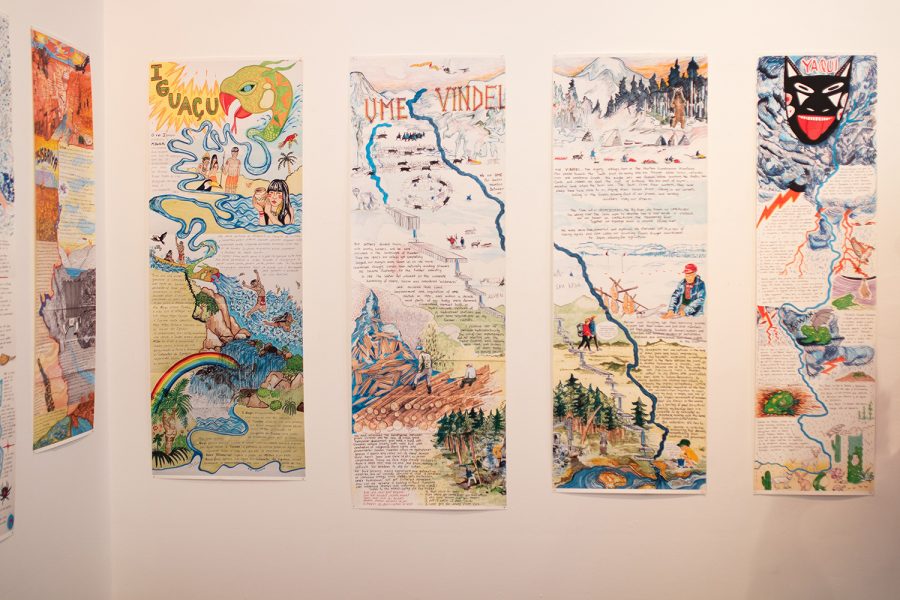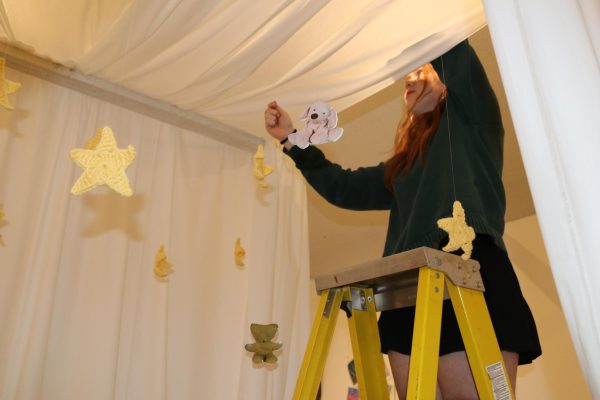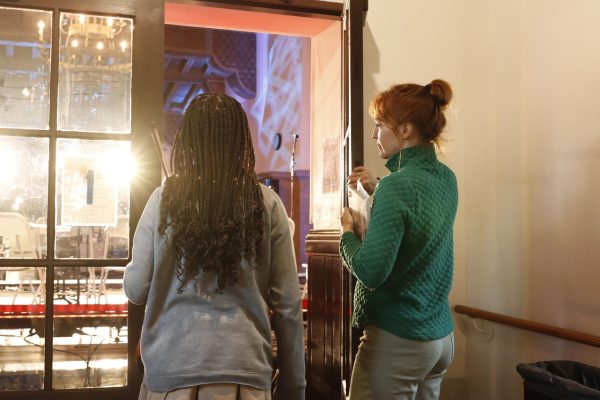Gallery show ‘In No Order’ explores ‘legacy and storytelling’
Photo credit: Marley Chaney
“In No Order,” an exhibit that explored ancestry and history, opened on March 9. The show was student-coordinated and featured four Los Angeles-based artists.
Students, parents and faculty poured into the Mutmuz Gallery in Chinatown on Saturday, March 9, from 6-9 p.m. and explored the personal and communal histories of four diverse Los Angeles artists.
Aviva Intveld and Isabel Kuh co-ran the new gallery show “In No Order” and chose to dive into histories and ancestries as a common thread through the four artists’ work. Through collaboration and communication, the entire Eastern Star Gallery team created the exhibit over the course of nearly nine months. The Eastern Star Gallery is located on the Archer campus, but this show was held in a gallery in Chinatown.
“The Eastern Star Gallery is a student-run contemporary art gallery. We have an on-campus space,” Intveld said, “[but] we are also independent of that space in that sometimes we have shows off campus where we collaborate with gallery owners and curators who are working professionally in the LA art scene.”
Intveld and Kuh contacted artists whose work they were interested in and ended up with four Los Angeles-based artists: Carolina Caycedo, Patricia Fernandez, Kang Seung Lee and Samantha Thomas.
“[The show] is based on the themes of time and what it means for the past to relate to the present and our experiences in terms of family and ancestry,” Kuh said. “Where you come from and what that story means and how it affects you — it’s also about legacy and archives and storytelling in general — how we tell stories about ourselves and our past in various methods.”
Intveld described the culmination of their work as ‘”really satisfying.”
Thomas focused on the Woolsey Fire, which affected her own home. Her work looked at the fire’s impact on families, homes and survivors’ lives. Caycedo looked at indigenous myths about river gods, which she connected to current social and political issues. Lee explored photojournalism in Los Angeles during the 1992 riots. Lastly, Fernandez reflected on the Spanish Civil War, as members of her family were executed for being political threats.
“So all of the artists are really taking things that have happened to them or their to families, or things that connect them some way heritage-wise,” Intveld said, “and then making it prevalent and accessible for the viewer.”
Junior Grace Wilson attended the opening of the gallery, where she saw other Archer teachers and classmates.
“I was super excited to go and see the accomplishments of my classmates because I know they’ve been working really hard all year to open this gallery,” Wilson said.
The process of the creation of the exhibit began around June or July, according to Intveld and Kuh. The two students and their team found a gallery space and then created press releases, contracts and budgets to ensure the creation and completion of the exhibit.
“In the midst of all of the that, we also do a lot of educational meeting for the rest of the gallery,” Intveld said. “We’re the co-directors, but we also work with a team of around 12 to 16 people who are involved with the gallery team at Archer.”
In their meetings, Intveld and Kuh said the group teaches and discusses subjects such as the history of graphic design, how to create visuals and how to work professionally in the art world.
“As the curator, you trust the artist to follow through with everything and be responsive and communicative, which all of these artists have been fantastic with,” Intveld said. “Then for the curator on the part of the artist, you trust the curator to display your work in a way that’s authentic to the original message.”
Members of their team take on jobs such as budgeting, communications or working on a particular installation. As curators for this particular exhibit, Intveld and Kuh shared the importance of trust in their relationships with the artists they work with and “seeing the bigger thread,” as Intveld said.
“It’s a lot of us, as curators, organizing and figuring out the layout to create a message that has an impact on the viewer and on the artists themselves so that they see their work in a new way,” Kuh said.
Intveld and Kuh had not met many any of the artists other than Thomas previous to the opening of the exhibit, but they feel they have gotten to know the artists well through their emailing and phone calls.
“It’s really individualized and independent — when it all comes together, you have the feeling that this is something that we as a team created together,” Intveld said. “It’s just amazing to have people see the show that we’ve been working on for so long, to see how they relate to it and to see what they take from it.”
Wilson described the gallery location as a “cool space:” in an alley near restaurants and other shops. Her favorite art piece was by Caycedo, map-like paintings about indigenous river gods.
“I felt like it was a really interesting gallery — there seemed to be a lot of variants among the art pieces, and yet they stuck to a really similar core idea,” Wilson said. “They felt cohesive but yet diverse.”
Kuh said that she doesn’t feel many people understand just how much of the gallery is actually student-run and described the gallery as “a pretty immersive experience.”
“The ultimate goal is that people find meaning in the work that we show,” Intveld said.








